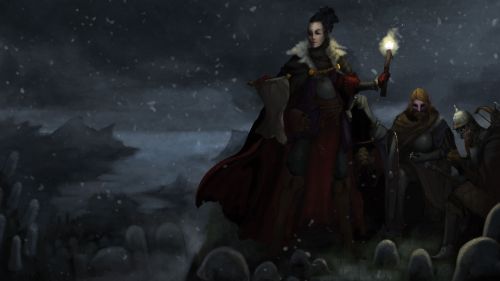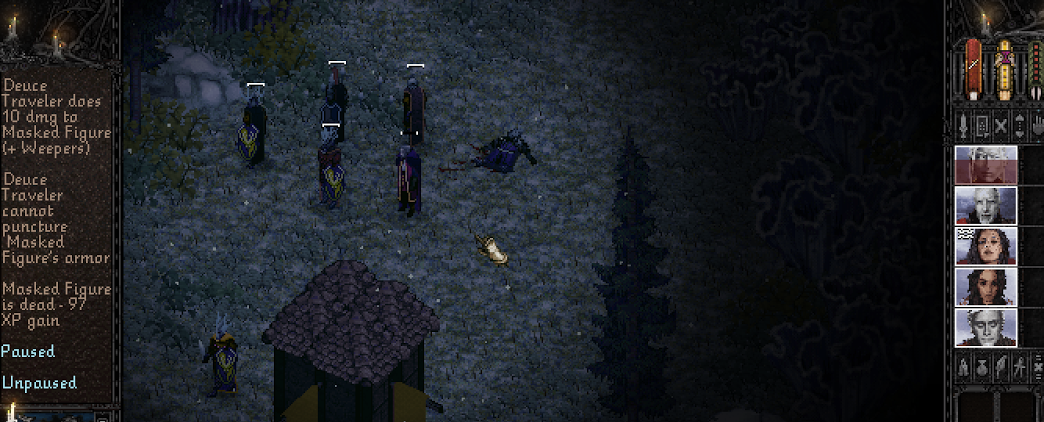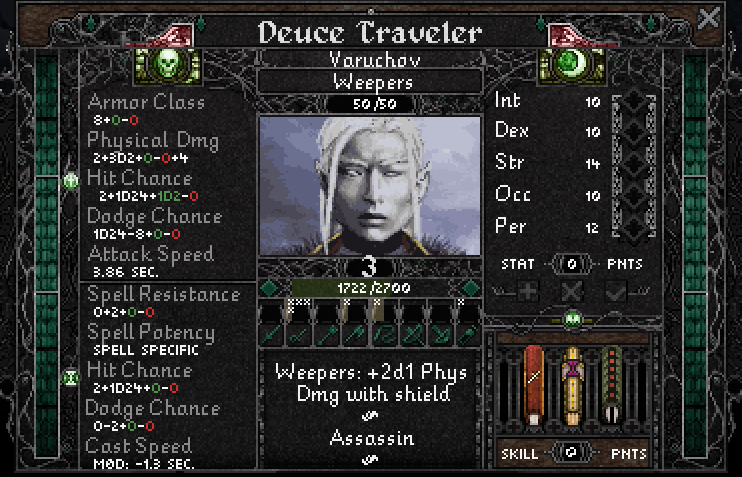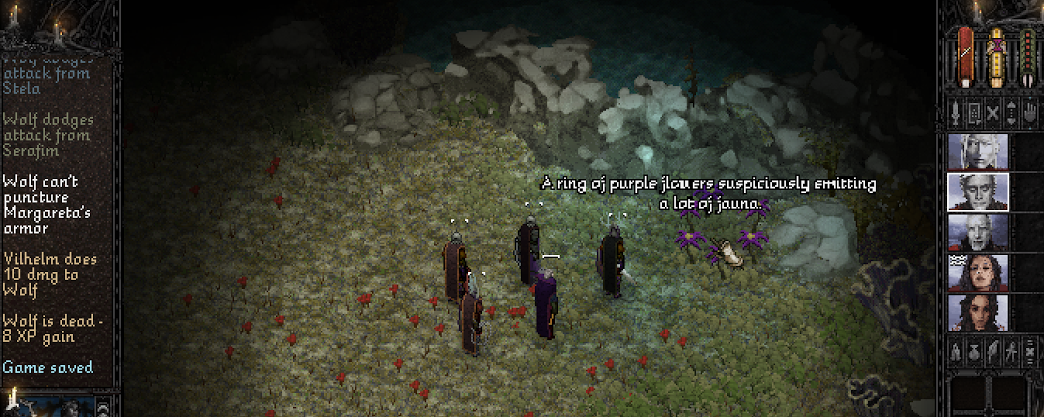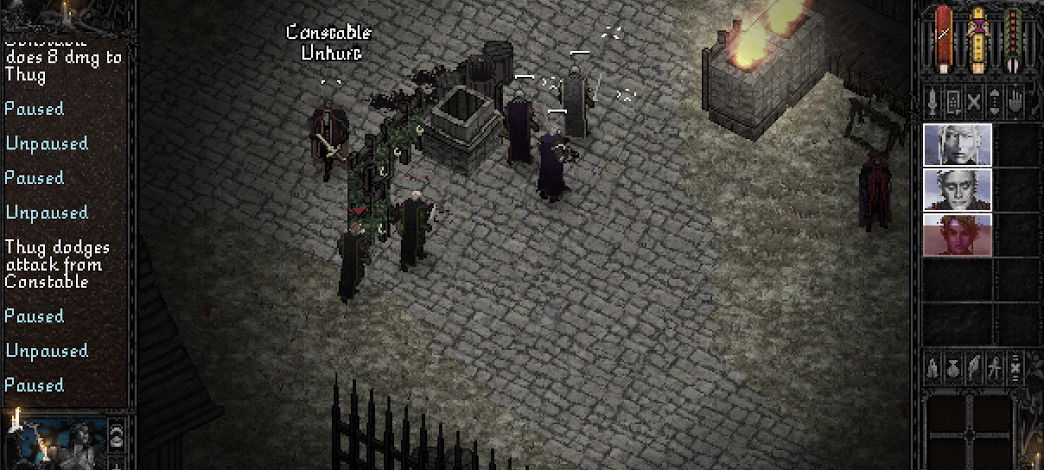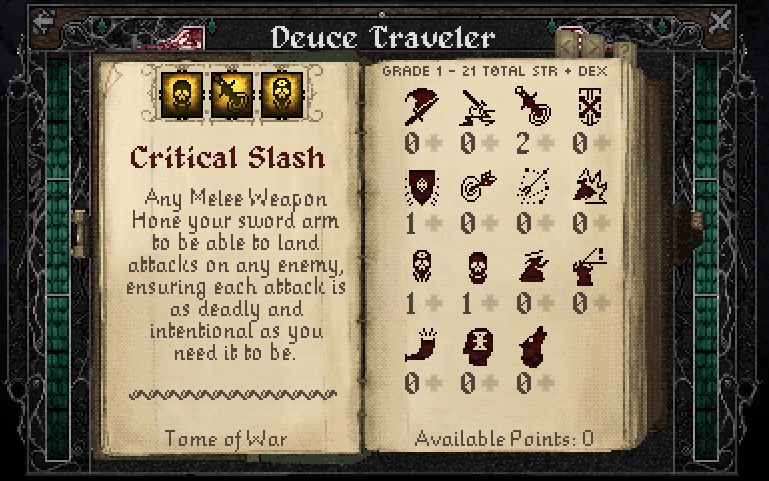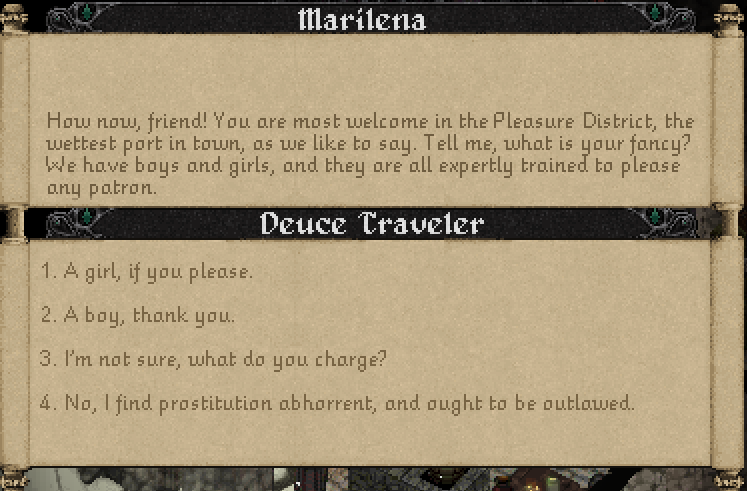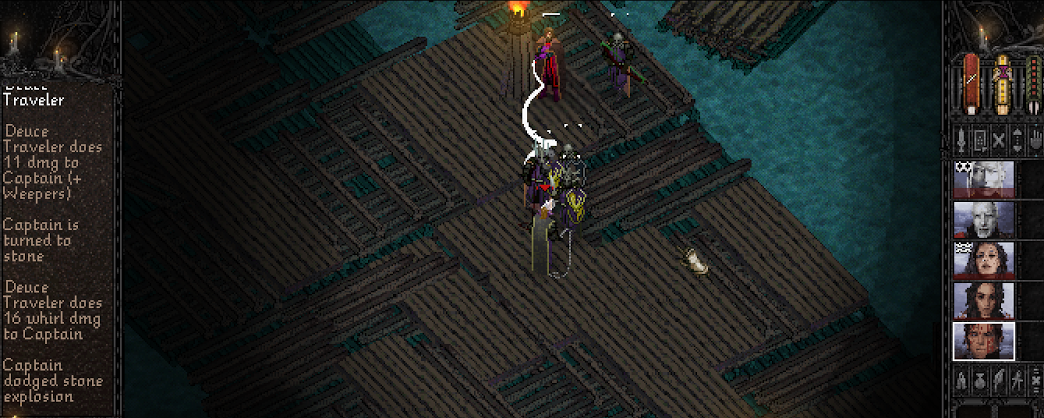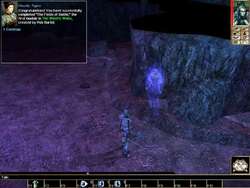RPG Codex Review: Serpent in the Staglands
RPG Codex Review: Serpent in the Staglands
Review - posted by Infinitron on Wed 15 June 2016, 20:06:46
Tags: Serpent in the Staglands; Whalenought StudiosWhalenought Studios' Serpent in the Staglands was an instant hit the day I posted about its Kickstarter campaign on our forums back in 2014. With its thoughtfully oldschool sensibilities and gorgeous pixel art, not to mention the developers' willingness to directly engage with our community, it quickly rose to the status of one of the Codex's "house indies", alongside worthy titles such as Underrail and Age of Decadence. For that reason, you'd think it would have been easy to find somebody to review the game when it was released in May 2015. Well, more than a year has passed since then, and the consensus on this still-unreviewed title remains unclear. Especially in the wake of Pillars of Eternity and all of its associated drama, many were eager to hold up Serpent in the Staglands as the true successor to the real-time with pause legacy. Others whispered that this alleged indie classic was not so great, and a few even lashed out at it using a particular acronym that I won't repeat here.
Clearly, only a Codex-sanctioned official review could clarify this matter once and for all. After two abortive attempts to produce such a review, including one that resulted in the mysterious disappearance of the reviewer from our forums, the esteemed Deuce Traveler volunteered to take a break from his Elder Scrolls review marathon to write one himself. It's fitting that today, just days after the success of Whalenought's second Kickstarter venture, I can finally offer you the official RPG Codex review of Serpent in the Staglands. Both the good:
This is going to sound odd, but my favorite aspect of Serpent in the Staglands is how it treats the player like an intelligent human being. You won't find a 30 minute tutorial explaining how to walk, manipulate items, or fight in this game. You will have to read the huge and detailed manual, and most likely consult it several times while you play, in order to understand its arcane user interface. I recommend ditching the in-game journal and writing down your own notes using good old pen and paper, and taking your time to read the dialogue. As stated earlier, combat can be extremely deadly and character progression is initially rather slow, so you'll have to pick your battles. There were many locations in the game that were too dangerous for my party at the beginning, so I had to temporarily abandon the idea of exploring them and find other, easier areas to develop my characters' combat proficiency before I could take them on. Money never ceases to be a concern - there always seemed to be some special item I wanted at the blacksmith's shop that kept me motivated to quest for further loot, even towards the end. It's hard for me to recall the last time I played a game that started off so challenging and didn't hold my hand, and it's hard to describe the thrill I felt when I finally earned enough money to buy my main character a better set of equipment, or when he reached his third level. Character progression is well-paced - slow enough to make you feel that you earned it, fast enough to prevent frustration.
And the bad:
Serpent in the Staglands' combat is real-time with pause, but it's pretty tactically simplistic. Although I enjoyed trying out new spells and skills, I ultimately found it to be a boring experience. Because combat is so fatal and I didn't want to experience the game's ridiculously long loading times (about 53 seconds on average) every time I lost a character, I ended up taking advantage of its poor enemy AI. My main tactic was to position one of my melee characters just at the edge of an enemy's field of vision to get him to attack, then retreat back to the rest of the party, overwhelming the suicidal enemy with ranged attacks and superior numbers. Wash, rinse, and repeat to get through an entire dungeon or wilderness area. Enemy encounters aren't very diverse, either. Even in the game's final stages, my party was still mostly fighting heavily armored melee opponents, with very few ranged and magic-using enemies to be found. Enemies often drop loot that does not match what you'd expect them to have. Sometimes I fought bandits and found a weapon and shield but no armor, even though they seemed to be be wearing leather. But then again, with the game's low level of graphical detail, maybe they were wearing just brown clothes?
Read the full article: RPG Codex Review: Serpent in the Staglands
Clearly, only a Codex-sanctioned official review could clarify this matter once and for all. After two abortive attempts to produce such a review, including one that resulted in the mysterious disappearance of the reviewer from our forums, the esteemed Deuce Traveler volunteered to take a break from his Elder Scrolls review marathon to write one himself. It's fitting that today, just days after the success of Whalenought's second Kickstarter venture, I can finally offer you the official RPG Codex review of Serpent in the Staglands. Both the good:
This is going to sound odd, but my favorite aspect of Serpent in the Staglands is how it treats the player like an intelligent human being. You won't find a 30 minute tutorial explaining how to walk, manipulate items, or fight in this game. You will have to read the huge and detailed manual, and most likely consult it several times while you play, in order to understand its arcane user interface. I recommend ditching the in-game journal and writing down your own notes using good old pen and paper, and taking your time to read the dialogue. As stated earlier, combat can be extremely deadly and character progression is initially rather slow, so you'll have to pick your battles. There were many locations in the game that were too dangerous for my party at the beginning, so I had to temporarily abandon the idea of exploring them and find other, easier areas to develop my characters' combat proficiency before I could take them on. Money never ceases to be a concern - there always seemed to be some special item I wanted at the blacksmith's shop that kept me motivated to quest for further loot, even towards the end. It's hard for me to recall the last time I played a game that started off so challenging and didn't hold my hand, and it's hard to describe the thrill I felt when I finally earned enough money to buy my main character a better set of equipment, or when he reached his third level. Character progression is well-paced - slow enough to make you feel that you earned it, fast enough to prevent frustration.
And the bad:
Serpent in the Staglands' combat is real-time with pause, but it's pretty tactically simplistic. Although I enjoyed trying out new spells and skills, I ultimately found it to be a boring experience. Because combat is so fatal and I didn't want to experience the game's ridiculously long loading times (about 53 seconds on average) every time I lost a character, I ended up taking advantage of its poor enemy AI. My main tactic was to position one of my melee characters just at the edge of an enemy's field of vision to get him to attack, then retreat back to the rest of the party, overwhelming the suicidal enemy with ranged attacks and superior numbers. Wash, rinse, and repeat to get through an entire dungeon or wilderness area. Enemy encounters aren't very diverse, either. Even in the game's final stages, my party was still mostly fighting heavily armored melee opponents, with very few ranged and magic-using enemies to be found. Enemies often drop loot that does not match what you'd expect them to have. Sometimes I fought bandits and found a weapon and shield but no armor, even though they seemed to be be wearing leather. But then again, with the game's low level of graphical detail, maybe they were wearing just brown clothes?
Read the full article: RPG Codex Review: Serpent in the Staglands
[Review by Deuce Traveler]
Serpent in the Staglands is an indie RPG developed by a husband-and-wife team known as Whalenought Studios and released back in 2015. It's influenced by beloved classics such as Darklands and Baldur's Gate. Before I begin, I want to state up front that I'm quite impressed with what this small team of two was able to accomplish, and I have faith in Whalenought Studios' future endeavors. But the game had some issues that gave me much frustration, and an ending that I disliked for reasons which you might not expect.
Visually, Serpent in the Staglands isn't all that impressive, as the game was developed on a small budget. There isn't much variety in architecture or clothing from location to location. The lack of detail can be off-putting - for example, it can be difficult to differentiate between children and adults. Sometimes pieces of furniture don't appear to be what their mouse-over tooltip says they are. The insides of temples, brothels, and government buildings all look the same, lacking the little touches that could have visually distinguished them. Because of the dark nature of the game, bright and vibrant colors are a rarity, and there's no area whose scenery will really embed itself in your mind. Artistically, the most evocative images in Serpent in the Staglands are the character portraits and load screens, which I felt enhanced the game's mood.
You play as Necholai, a lunar god visiting his worshippers during an annual celebration in his honor. During the visit, Necholai is trapped in his mortal body and unable to return to his celestial form, kicking off his search for answers, which is the main quest of Serpent in the Staglands. You do get to create a character though, in a two-phase character creation sequence. In the first phase, you answer several multiple-choice questions about Necholai's personality and historical background. Your answers here have mostly cosmetic effects, changing various plot details and the responses you get from some of the characters you meet. In at least one case, I found the results to be interesting in concept, but flat in execution. For instance, in one character creation question, you're asked which other god in the Staglands pantheon Necholai is associated with. In the game, I found four similarly dressed priests of different gods standing together in a small room. When I tried asking the priests for aid, three of them gave me a generic refusal, and the fourth one, who was a worshipper of the god I'd picked, gave my character the help he sought. This was supposed to be a cool moment that makes character creation feel meaningful and the world feel more real, but it had the opposite effect on me. The chamber and its occupants felt tacked on and out of place - four priests of completely different gods just hanging out in a multi-floor building that wasn't even solely a place of worship. I would expect them to each be in their own temple, with different clothes and architectures giving them a sense of individuality. What the game did took me out of the world rather than deeper into it.
In the second phase of character creation, you select a race and allocate points into physical attributes and skills. Your race determines what region of the world your character is from, with paragraphs of text describing the geographic, political, and historical details of each one. These descriptions and the other background information found in the game's impressively large manual show how seriously Whalenought took their worldbuilding. Each race has its own minor bonuses. For example, a Varuchov character will do slightly more damage with a shield bash when fighting with a weapon-and-shield style of combat. This is a departure from many other RPGs, where races often have extreme bonuses and penalties. Personally, I welcome this more subdued and flavorful approach, as it reduces the temptation to min-max and makes each race a viable choice. Although min-maxing wouldn't be so easy in this game anyway, since there aren't any dump stats. All of your attributes are important.
You're going to want to determine early on what kind of build you want for your character, because there are dozens of skills to choose from, and each requires a certain threshold of attributes to access it. Typically you'll have a character who is either a physical combatant or a spellcaster, but the choices don't end there. Physical characters need to choose whether to specialize in heavy weapons, light weapons with shields, whips, or bows. Spellcasters have access to different spell schools, allowing them to specialize in healing and harming or in buffing and debuffing. You can create hybrid characters as well. For example, an archer who can cast curses, or a combat cleric who is a decent melee fighter and can also heal. The problem with building hybrid characters is that you only receive two skill points every time you level up, so you can't be wasteful in how you allocate them. You'll usually want to keep putting points into the same skills so that your light weapons expert stabs faster and your heavy weapons expert hits harder. Serpent in the Staglands forces you to think and pay attention to your actions, and careless character development will lead to characters who are severely underpowered.
That said, you'll be underpowered at the beginning of the game no matter how you build your character. You start out with some basic equipment and a party of recruits. In my playthrough, that meant my character had to survive his first few fights as a frontline fighter with only a short blade and leather armor. Death comes quickly in the Staglands, and it's also permanent - there is no way to revive fallen party members or raise them from the dead. If one of your companions dies, you'll have to either reload a saved game, or accept the situation and try to recruit someone else to take his place. There are a large number of potential companions in the game that can be recruited or hired to bolster your ranks. These characters receive minimalistic characterization that has only a minor effect on the story. You'll get a feel for their personality when you first speak with one of them, and on occasion if you're going somewhere they don't want to go, but other than that it's rare to see the companions have any impact. Not once did I have a lengthy conversation with one of them, nor did I get a side quest, even when it seemed like there should be one. Come across a local noble who previously harmed the two young ladies in your party, and continues to enslave their old acquaintances? Well too bad, because there's nothing you can do to help your traumatized companions in any way, even if you kill the noble, or have a nearby giant spider to do it for you. In fact, you can do several horrible things in this game without seeing any repercussions until right before the end.
Not everything in Serpent in the Staglands feels so hollow. The game's overall backstory is well done, and the starting and ending areas in particular are full of dialogue and other interesting information. There are a ton of optional quests and hidden locations that will appeal to those who love exploration, and a lot of secrets that can only be revealed with the use of the right skill or spell. For instance, there are a number of locations that can only be accessed by a character who has polymorphed himself into a smaller form, such as a cat. There's at least one type of guardian creature that can only be defeated by knocking it down first, which you wouldn't know unless you took the time to read about it. Many characters in the game, ranging from nobles to woodland animals, have unique dialogue options that can only be accessed by using social skills. These options often unlock sidequests and reveal background lore, especially in the first few towns. None of these puzzles are very difficult, but they require so much reading and experimenting that I doubt anybody could uncover all of their secrets in a single playthrough.
But if Serpent in the Staglands' beginning and end are good, then much of what is in the middle seems empty or devoid of substance. Darklands, which influenced this game, succeeded at creating a living world because every location was infused with cultural and religious references, but here so much looks the same. There's a long dock in one city that takes forever to reach the end of, with little of interest in between and a locked door you can't access until the endgame. Hordes of generic NPCs mill around to fill space but otherwise have nothing to say or do. Places of worship are devoid of personality and rarely seen despite the religious nature of the game's plot. Magic items with simple, unengaging descriptions abound. There's more than one location in the game where you can kill slavers and their slaves won't notice. On the flipside, there are seemingly small things you can do in Serpent in the Staglands that can have a huge impact. For example, at one point in my playthrough I suggested to a group of woodland spirits that they try practicing their dangerous shenanigans in a nearby town, only to find the entire place overrun and the entire population massacred upon my return. Events like these make the seemingly unfinished state of much of the rest of the game feel even more jarring.
During your travels in the Staglands, you will inevitably find yourself engaged in combat, as the woods are filled with monsters and even populated areas have their fair share of bandits. When combat does occur, your melee and ranged combat characters will attack the opponents you select for them, reinforced by up to three pre-selected combat skills that can grant bonuses such as the ability to knock down opponents or increased critical hit chance. Your spellcasters have dozens of possible spells to choose from, depending on your preferred gameplay style. Some players might prefer to cast spells that damage groups of foes over time or heal allies every few seconds, but the one I liked was a particular spell that has the ability to petrify enemies, often leading to instant kills when they shatter. Another spell I enjoyed using was Hallucination, which causes opponents to turn and flee, not fighting back even as they're stabbed to death by your other party members. Magic can be used at will, and is not held back by spell memorization or mana requirements. To balance things out, it's a little less important than in other fantasy RPGs, and not as dangerous or critical. You'll still want to bring at least one spellcaster with you, but they won't be casting anything as powerful as a D&D-style fireball spell that can end a fight instantly. What they can do is restore your party's health after every battle, eliminating the need to rest at inns. In fact, the only reason I ever had to return to civilization in Serpent in the Staglands was to sell loot or to receive the reward for completing a quest. This allowed the developers to make the game's battles much more difficult, since your party is expected to be at full strength at all times.
Serpent in the Staglands' combat is real-time with pause, but it's pretty tactically simplistic. Although I enjoyed trying out new spells and skills, I ultimately found it to be a boring experience. Because combat is so fatal and I didn't want to experience the game's ridiculously long loading times (about 53 seconds on average) every time I lost a character, I ended up taking advantage of its poor enemy AI. My main tactic was to position one of my melee characters just at the edge of an enemy's field of vision to get him to attack, then retreat back to the rest of the party, overwhelming the suicidal enemy with ranged attacks and superior numbers. Wash, rinse, and repeat to get through an entire dungeon or wilderness area. Enemy encounters aren't very diverse, either. Even in the game's final stages, my party was still mostly fighting heavily armored melee opponents, with very few ranged and magic-using enemies to be found. Enemies often drop loot that does not match what you'd expect them to have. Sometimes I fought bandits and found a weapon and shield but no armor, even though they seemed to be be wearing leather. But then again, with the game's low level of graphical detail, maybe they were wearing just brown clothes?
The game has all sorts of bugs and oversights that you can exploit to your benefit. For example, you can gain experience points when allied characters (including city guards) kill enemies, even if you weren't involved in the fight at all. There's another point in the game where just opening several random containers with some knick-knacks inside of them will grant you a huge amount of experience. Once, I managed to enter a certain walled town without a hitch, only to encounter a guard on my way out who tried to charge me money to enter (which of course I declined to do since I had already finished my business inside). Another time, I was asked by a local constable to take down several local criminals, but when I found them and led them on a merry goose chase through town, the local law enforcement did not recognize them as foes, forcing me to defeat them without any support. I will say that despite the bugs and the long loading times, the game was quite stable, and I appreciated the ability to seamlessly resize its window.
This is going to sound odd, but my favorite aspect of Serpent in the Staglands is how it treats the player like an intelligent human being. You won't find a 30 minute tutorial explaining how to walk, manipulate items, or fight in this game. You will have to read the huge and detailed manual, and most likely consult it several times while you play, in order to understand its arcane user interface. I recommend ditching the in-game journal and writing down your own notes using good old pen and paper, and taking your time to read the dialogue. As stated earlier, combat can be extremely deadly and character progression is initially rather slow, so you'll have to pick your battles. There were many locations in the game that were too dangerous for my party at the beginning, so I had to temporarily abandon the idea of exploring them and find other, easier areas to develop my characters' combat proficiency before I could take them on. Money never ceases to be a concern - there always seemed to be some special item I wanted at the blacksmith's shop that kept me motivated to quest for further loot, even towards the end. It's hard for me to recall the last time I played a game that started off so challenging and didn't hold my hand, and it's hard to describe the thrill I felt when I finally earned enough money to buy my main character a better set of equipment, or when he reached his third level. Character progression is well-paced - slow enough to make you feel that you earned it, fast enough to prevent frustration.
Some of you will love Serpent in the Staglands for its gritty, adult atmosphere, but personally I feel the game went too far in this direction. It is grimdark to a fault. The one character who supports you without any ulterior motives is gratuitously killed at a certain point in the story. You are told this in a brief conversation with a character who you never meet again. Everyone else you meet is some category of asshole. There are people who live right outside the game's starting location who treat you suspiciously because you appear to be a foreigner, even if you're travelling with companions who are from the area. You meet one character who wants to join you because she is tired of her backwater village and the people who live there. There are a number of characters who will try to convince you to sell one of your party members into slavery. You encounter a couple of thugs who kill an adulterous woman after her husband put a bounty on her. Another character craves battle and joins you because your trip promises the potential for violence. You can rescue two girls from a brothel, and if you say you can only take one of them with you, the older one is ready to ditch the younger one without missing a beat. (Both of them are highly trained in violence.) There's one town where the people watch your every move with suspicion. The police (who are called arbiters) act like entitled thugs. Their chief openly admits to being too important to be on the front lines with his men. Many conversations in the game end in violence no matter what your response or how high your speech skills are. Everyone seems to be in a competition for the title of Jerky McAssHat.
The problem with grimdark is that it makes me not care about the people I meet in the game. In the Ultima series, I wanted to help the people of Britannia because many of them seemed good and decent and I was invested in their welfare. I felt the same way even about Fallout, where there were plenty of horrible people, but also many honest ones just trying to scrape, and it was pure enjoyment when I saw in the ending slides that my actions had helped them. But in Serpent in the Staglands, I never felt that any decent-seeming character was fleshed out enough for me to care about whether or not they or their settlement had survived the chaos of my passing. Your companions aren't tied closely enough to the game's backstory or locations and don't feel as if they're part of what's happening in the region, and everyone that your main character could possibly have a larger connection with is either killed off before you meet them, killed off shortly after you meet them, or is just there to deliver exposition.
And that's a damn shame, because at the end of the game you'll realize that it was actually trying to be something of an elaborate morality tale. Serpent in the Staglands' endgame has been so controversial that I feel compelled to write about it, so this section of the review will be mildly spoilery. On their first playthrough, most players are going to get the 'bad' ending, where the consequences of several decisions made over the course of the game lead to the doom of a large number of people. This has been a source of rage for many, but personally I have no problem with the fact that my actions were condemned as evil, and approve of how you're not informed of their ramifications until it's too late. After all, it was I who on a mischievous whim sent the forest spirits against an unsuspecting town (although I thought it would end up being funny, not with the entire town destroyed). It was also I who went after all those bounties for the easy cash and experience points, even though at least one of the guys I killed seemed a decent enough chap, not to mention I had to kill an entire tavern of thugs to get to him. And yes, I did murder an arbiter away from prying eyes when he tried to shake me down. So I feel I deserved to get called out for those actions.
On the other hand, I never used my powers to manipulate others, fled to avoid slaughtering innocents such as possessed children whenever I could, freed numerous slaves, and even showed mercy to a major antagonist. Yet the game weighed the balance against me because my good intentions weren't recognized by its arbitrary moral compass. Serpent in the Staglands manipulates you into performing horrible actions and then accuses you of wrongdoing even when you never intended any harm. For example, at one point in the game, I gave someone a gift that ended up doing an awful amount of damage, and because I lacked the skills to properly examine the gift, I didn't even realize I'd done any harm until much later. At another point, I encountered a certain creature who was prone to violence and had already murdered several humans, so was it really evil when I refused to sell one of my party members to him and had to fight him to the death instead? The arbitrary nature of how your actions are measured in the endgame is what bothered me, along with its condescending tone.
I understand the thinking behind this narrative decision, but the game takes away too much of your free will as a player, forcing you to play an immortal with a long history, and making you act in a certain way at the end even if you never envisioned your character acting in such a manner. The ending actually deliberately forces you to go out of character no matter how you played - if you tried to be a peaceful character, you'll be forced to kill, but if you were a violent berserker then you can finish the game without fighting the final antagonist. In my playthrough, I never used my mind control powers on anybody, freely let my party members leave whenever they had business elsewhere, and respected their opinions, so it boggled my mind when I was forced to fight them in an overmatched slugfest at the end of the game. At least the bleak ending gives you a reason replay the game with different choices in order to get the 'good' ending, which can be quite challenging without the experience and gold rewards from those bounties.
So would I recommend Serpent in the Staglands, despite all of its faults? Yes, especially for the hardcore RPG fans here on the Codex. The issues I raged about in this review bother me because I can see how much better the game could have been, but its lack of handholding, numerous secrets, and hidden side quests make for a deep roleplaying experience with lots of replayability. Every person who plays this game is going to have a different story, with its wide variety of skills, spells, and party compositions. It's a challenging game full of lore and mystery, and those who play it will have much to talk about for years to come.
Serpent in the Staglands is an indie RPG developed by a husband-and-wife team known as Whalenought Studios and released back in 2015. It's influenced by beloved classics such as Darklands and Baldur's Gate. Before I begin, I want to state up front that I'm quite impressed with what this small team of two was able to accomplish, and I have faith in Whalenought Studios' future endeavors. But the game had some issues that gave me much frustration, and an ending that I disliked for reasons which you might not expect.
Visually, Serpent in the Staglands isn't all that impressive, as the game was developed on a small budget. There isn't much variety in architecture or clothing from location to location. The lack of detail can be off-putting - for example, it can be difficult to differentiate between children and adults. Sometimes pieces of furniture don't appear to be what their mouse-over tooltip says they are. The insides of temples, brothels, and government buildings all look the same, lacking the little touches that could have visually distinguished them. Because of the dark nature of the game, bright and vibrant colors are a rarity, and there's no area whose scenery will really embed itself in your mind. Artistically, the most evocative images in Serpent in the Staglands are the character portraits and load screens, which I felt enhanced the game's mood.
You play as Necholai, a lunar god visiting his worshippers during an annual celebration in his honor. During the visit, Necholai is trapped in his mortal body and unable to return to his celestial form, kicking off his search for answers, which is the main quest of Serpent in the Staglands. You do get to create a character though, in a two-phase character creation sequence. In the first phase, you answer several multiple-choice questions about Necholai's personality and historical background. Your answers here have mostly cosmetic effects, changing various plot details and the responses you get from some of the characters you meet. In at least one case, I found the results to be interesting in concept, but flat in execution. For instance, in one character creation question, you're asked which other god in the Staglands pantheon Necholai is associated with. In the game, I found four similarly dressed priests of different gods standing together in a small room. When I tried asking the priests for aid, three of them gave me a generic refusal, and the fourth one, who was a worshipper of the god I'd picked, gave my character the help he sought. This was supposed to be a cool moment that makes character creation feel meaningful and the world feel more real, but it had the opposite effect on me. The chamber and its occupants felt tacked on and out of place - four priests of completely different gods just hanging out in a multi-floor building that wasn't even solely a place of worship. I would expect them to each be in their own temple, with different clothes and architectures giving them a sense of individuality. What the game did took me out of the world rather than deeper into it.
In the second phase of character creation, you select a race and allocate points into physical attributes and skills. Your race determines what region of the world your character is from, with paragraphs of text describing the geographic, political, and historical details of each one. These descriptions and the other background information found in the game's impressively large manual show how seriously Whalenought took their worldbuilding. Each race has its own minor bonuses. For example, a Varuchov character will do slightly more damage with a shield bash when fighting with a weapon-and-shield style of combat. This is a departure from many other RPGs, where races often have extreme bonuses and penalties. Personally, I welcome this more subdued and flavorful approach, as it reduces the temptation to min-max and makes each race a viable choice. Although min-maxing wouldn't be so easy in this game anyway, since there aren't any dump stats. All of your attributes are important.
You're going to want to determine early on what kind of build you want for your character, because there are dozens of skills to choose from, and each requires a certain threshold of attributes to access it. Typically you'll have a character who is either a physical combatant or a spellcaster, but the choices don't end there. Physical characters need to choose whether to specialize in heavy weapons, light weapons with shields, whips, or bows. Spellcasters have access to different spell schools, allowing them to specialize in healing and harming or in buffing and debuffing. You can create hybrid characters as well. For example, an archer who can cast curses, or a combat cleric who is a decent melee fighter and can also heal. The problem with building hybrid characters is that you only receive two skill points every time you level up, so you can't be wasteful in how you allocate them. You'll usually want to keep putting points into the same skills so that your light weapons expert stabs faster and your heavy weapons expert hits harder. Serpent in the Staglands forces you to think and pay attention to your actions, and careless character development will lead to characters who are severely underpowered.
That said, you'll be underpowered at the beginning of the game no matter how you build your character. You start out with some basic equipment and a party of recruits. In my playthrough, that meant my character had to survive his first few fights as a frontline fighter with only a short blade and leather armor. Death comes quickly in the Staglands, and it's also permanent - there is no way to revive fallen party members or raise them from the dead. If one of your companions dies, you'll have to either reload a saved game, or accept the situation and try to recruit someone else to take his place. There are a large number of potential companions in the game that can be recruited or hired to bolster your ranks. These characters receive minimalistic characterization that has only a minor effect on the story. You'll get a feel for their personality when you first speak with one of them, and on occasion if you're going somewhere they don't want to go, but other than that it's rare to see the companions have any impact. Not once did I have a lengthy conversation with one of them, nor did I get a side quest, even when it seemed like there should be one. Come across a local noble who previously harmed the two young ladies in your party, and continues to enslave their old acquaintances? Well too bad, because there's nothing you can do to help your traumatized companions in any way, even if you kill the noble, or have a nearby giant spider to do it for you. In fact, you can do several horrible things in this game without seeing any repercussions until right before the end.
Not everything in Serpent in the Staglands feels so hollow. The game's overall backstory is well done, and the starting and ending areas in particular are full of dialogue and other interesting information. There are a ton of optional quests and hidden locations that will appeal to those who love exploration, and a lot of secrets that can only be revealed with the use of the right skill or spell. For instance, there are a number of locations that can only be accessed by a character who has polymorphed himself into a smaller form, such as a cat. There's at least one type of guardian creature that can only be defeated by knocking it down first, which you wouldn't know unless you took the time to read about it. Many characters in the game, ranging from nobles to woodland animals, have unique dialogue options that can only be accessed by using social skills. These options often unlock sidequests and reveal background lore, especially in the first few towns. None of these puzzles are very difficult, but they require so much reading and experimenting that I doubt anybody could uncover all of their secrets in a single playthrough.
But if Serpent in the Staglands' beginning and end are good, then much of what is in the middle seems empty or devoid of substance. Darklands, which influenced this game, succeeded at creating a living world because every location was infused with cultural and religious references, but here so much looks the same. There's a long dock in one city that takes forever to reach the end of, with little of interest in between and a locked door you can't access until the endgame. Hordes of generic NPCs mill around to fill space but otherwise have nothing to say or do. Places of worship are devoid of personality and rarely seen despite the religious nature of the game's plot. Magic items with simple, unengaging descriptions abound. There's more than one location in the game where you can kill slavers and their slaves won't notice. On the flipside, there are seemingly small things you can do in Serpent in the Staglands that can have a huge impact. For example, at one point in my playthrough I suggested to a group of woodland spirits that they try practicing their dangerous shenanigans in a nearby town, only to find the entire place overrun and the entire population massacred upon my return. Events like these make the seemingly unfinished state of much of the rest of the game feel even more jarring.
During your travels in the Staglands, you will inevitably find yourself engaged in combat, as the woods are filled with monsters and even populated areas have their fair share of bandits. When combat does occur, your melee and ranged combat characters will attack the opponents you select for them, reinforced by up to three pre-selected combat skills that can grant bonuses such as the ability to knock down opponents or increased critical hit chance. Your spellcasters have dozens of possible spells to choose from, depending on your preferred gameplay style. Some players might prefer to cast spells that damage groups of foes over time or heal allies every few seconds, but the one I liked was a particular spell that has the ability to petrify enemies, often leading to instant kills when they shatter. Another spell I enjoyed using was Hallucination, which causes opponents to turn and flee, not fighting back even as they're stabbed to death by your other party members. Magic can be used at will, and is not held back by spell memorization or mana requirements. To balance things out, it's a little less important than in other fantasy RPGs, and not as dangerous or critical. You'll still want to bring at least one spellcaster with you, but they won't be casting anything as powerful as a D&D-style fireball spell that can end a fight instantly. What they can do is restore your party's health after every battle, eliminating the need to rest at inns. In fact, the only reason I ever had to return to civilization in Serpent in the Staglands was to sell loot or to receive the reward for completing a quest. This allowed the developers to make the game's battles much more difficult, since your party is expected to be at full strength at all times.
Serpent in the Staglands' combat is real-time with pause, but it's pretty tactically simplistic. Although I enjoyed trying out new spells and skills, I ultimately found it to be a boring experience. Because combat is so fatal and I didn't want to experience the game's ridiculously long loading times (about 53 seconds on average) every time I lost a character, I ended up taking advantage of its poor enemy AI. My main tactic was to position one of my melee characters just at the edge of an enemy's field of vision to get him to attack, then retreat back to the rest of the party, overwhelming the suicidal enemy with ranged attacks and superior numbers. Wash, rinse, and repeat to get through an entire dungeon or wilderness area. Enemy encounters aren't very diverse, either. Even in the game's final stages, my party was still mostly fighting heavily armored melee opponents, with very few ranged and magic-using enemies to be found. Enemies often drop loot that does not match what you'd expect them to have. Sometimes I fought bandits and found a weapon and shield but no armor, even though they seemed to be be wearing leather. But then again, with the game's low level of graphical detail, maybe they were wearing just brown clothes?
The game has all sorts of bugs and oversights that you can exploit to your benefit. For example, you can gain experience points when allied characters (including city guards) kill enemies, even if you weren't involved in the fight at all. There's another point in the game where just opening several random containers with some knick-knacks inside of them will grant you a huge amount of experience. Once, I managed to enter a certain walled town without a hitch, only to encounter a guard on my way out who tried to charge me money to enter (which of course I declined to do since I had already finished my business inside). Another time, I was asked by a local constable to take down several local criminals, but when I found them and led them on a merry goose chase through town, the local law enforcement did not recognize them as foes, forcing me to defeat them without any support. I will say that despite the bugs and the long loading times, the game was quite stable, and I appreciated the ability to seamlessly resize its window.
This is going to sound odd, but my favorite aspect of Serpent in the Staglands is how it treats the player like an intelligent human being. You won't find a 30 minute tutorial explaining how to walk, manipulate items, or fight in this game. You will have to read the huge and detailed manual, and most likely consult it several times while you play, in order to understand its arcane user interface. I recommend ditching the in-game journal and writing down your own notes using good old pen and paper, and taking your time to read the dialogue. As stated earlier, combat can be extremely deadly and character progression is initially rather slow, so you'll have to pick your battles. There were many locations in the game that were too dangerous for my party at the beginning, so I had to temporarily abandon the idea of exploring them and find other, easier areas to develop my characters' combat proficiency before I could take them on. Money never ceases to be a concern - there always seemed to be some special item I wanted at the blacksmith's shop that kept me motivated to quest for further loot, even towards the end. It's hard for me to recall the last time I played a game that started off so challenging and didn't hold my hand, and it's hard to describe the thrill I felt when I finally earned enough money to buy my main character a better set of equipment, or when he reached his third level. Character progression is well-paced - slow enough to make you feel that you earned it, fast enough to prevent frustration.
Some of you will love Serpent in the Staglands for its gritty, adult atmosphere, but personally I feel the game went too far in this direction. It is grimdark to a fault. The one character who supports you without any ulterior motives is gratuitously killed at a certain point in the story. You are told this in a brief conversation with a character who you never meet again. Everyone else you meet is some category of asshole. There are people who live right outside the game's starting location who treat you suspiciously because you appear to be a foreigner, even if you're travelling with companions who are from the area. You meet one character who wants to join you because she is tired of her backwater village and the people who live there. There are a number of characters who will try to convince you to sell one of your party members into slavery. You encounter a couple of thugs who kill an adulterous woman after her husband put a bounty on her. Another character craves battle and joins you because your trip promises the potential for violence. You can rescue two girls from a brothel, and if you say you can only take one of them with you, the older one is ready to ditch the younger one without missing a beat. (Both of them are highly trained in violence.) There's one town where the people watch your every move with suspicion. The police (who are called arbiters) act like entitled thugs. Their chief openly admits to being too important to be on the front lines with his men. Many conversations in the game end in violence no matter what your response or how high your speech skills are. Everyone seems to be in a competition for the title of Jerky McAssHat.
The problem with grimdark is that it makes me not care about the people I meet in the game. In the Ultima series, I wanted to help the people of Britannia because many of them seemed good and decent and I was invested in their welfare. I felt the same way even about Fallout, where there were plenty of horrible people, but also many honest ones just trying to scrape, and it was pure enjoyment when I saw in the ending slides that my actions had helped them. But in Serpent in the Staglands, I never felt that any decent-seeming character was fleshed out enough for me to care about whether or not they or their settlement had survived the chaos of my passing. Your companions aren't tied closely enough to the game's backstory or locations and don't feel as if they're part of what's happening in the region, and everyone that your main character could possibly have a larger connection with is either killed off before you meet them, killed off shortly after you meet them, or is just there to deliver exposition.
And that's a damn shame, because at the end of the game you'll realize that it was actually trying to be something of an elaborate morality tale. Serpent in the Staglands' endgame has been so controversial that I feel compelled to write about it, so this section of the review will be mildly spoilery. On their first playthrough, most players are going to get the 'bad' ending, where the consequences of several decisions made over the course of the game lead to the doom of a large number of people. This has been a source of rage for many, but personally I have no problem with the fact that my actions were condemned as evil, and approve of how you're not informed of their ramifications until it's too late. After all, it was I who on a mischievous whim sent the forest spirits against an unsuspecting town (although I thought it would end up being funny, not with the entire town destroyed). It was also I who went after all those bounties for the easy cash and experience points, even though at least one of the guys I killed seemed a decent enough chap, not to mention I had to kill an entire tavern of thugs to get to him. And yes, I did murder an arbiter away from prying eyes when he tried to shake me down. So I feel I deserved to get called out for those actions.
On the other hand, I never used my powers to manipulate others, fled to avoid slaughtering innocents such as possessed children whenever I could, freed numerous slaves, and even showed mercy to a major antagonist. Yet the game weighed the balance against me because my good intentions weren't recognized by its arbitrary moral compass. Serpent in the Staglands manipulates you into performing horrible actions and then accuses you of wrongdoing even when you never intended any harm. For example, at one point in the game, I gave someone a gift that ended up doing an awful amount of damage, and because I lacked the skills to properly examine the gift, I didn't even realize I'd done any harm until much later. At another point, I encountered a certain creature who was prone to violence and had already murdered several humans, so was it really evil when I refused to sell one of my party members to him and had to fight him to the death instead? The arbitrary nature of how your actions are measured in the endgame is what bothered me, along with its condescending tone.
I understand the thinking behind this narrative decision, but the game takes away too much of your free will as a player, forcing you to play an immortal with a long history, and making you act in a certain way at the end even if you never envisioned your character acting in such a manner. The ending actually deliberately forces you to go out of character no matter how you played - if you tried to be a peaceful character, you'll be forced to kill, but if you were a violent berserker then you can finish the game without fighting the final antagonist. In my playthrough, I never used my mind control powers on anybody, freely let my party members leave whenever they had business elsewhere, and respected their opinions, so it boggled my mind when I was forced to fight them in an overmatched slugfest at the end of the game. At least the bleak ending gives you a reason replay the game with different choices in order to get the 'good' ending, which can be quite challenging without the experience and gold rewards from those bounties.
So would I recommend Serpent in the Staglands, despite all of its faults? Yes, especially for the hardcore RPG fans here on the Codex. The issues I raged about in this review bother me because I can see how much better the game could have been, but its lack of handholding, numerous secrets, and hidden side quests make for a deep roleplaying experience with lots of replayability. Every person who plays this game is going to have a different story, with its wide variety of skills, spells, and party compositions. It's a challenging game full of lore and mystery, and those who play it will have much to talk about for years to come.
There are 76 comments on RPG Codex Review: Serpent in the Staglands





